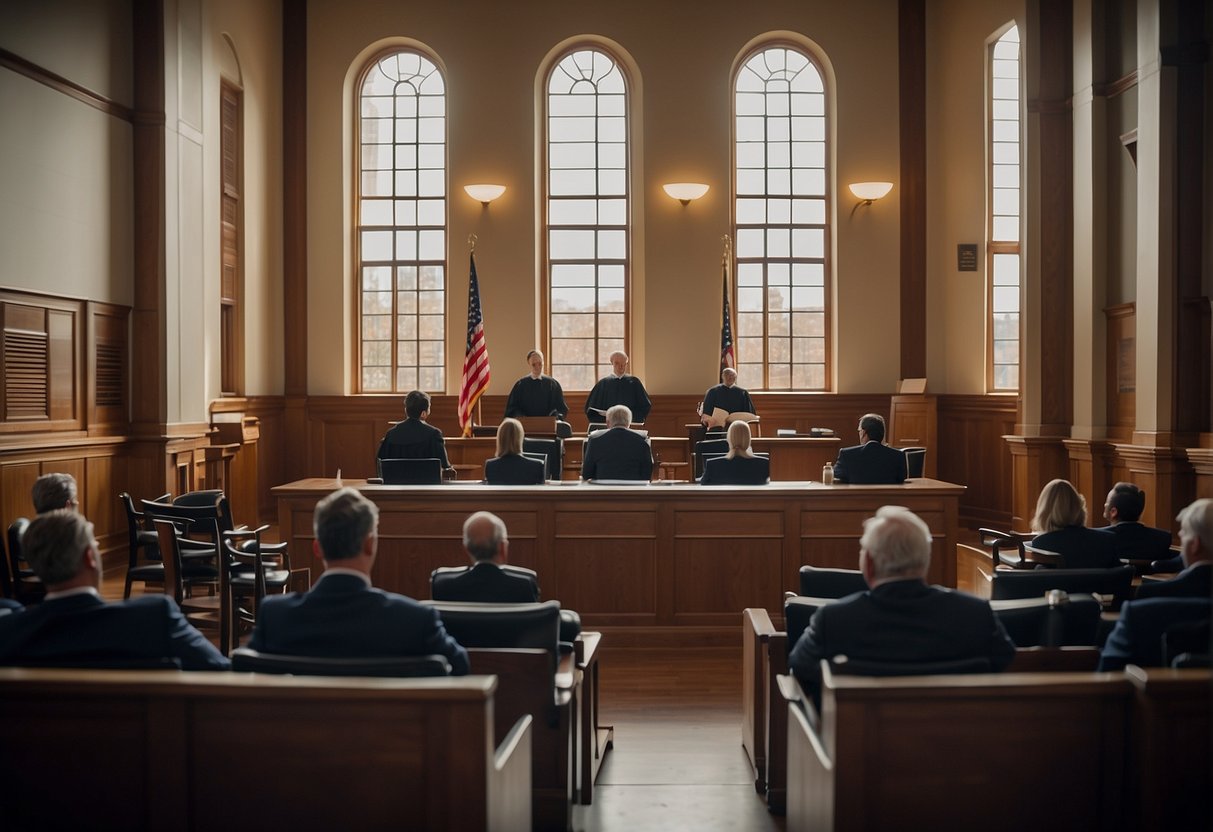Understanding Appeals in Personal Injury Cases

After a personal injury trial concludes, the appeals process offers a pathway for the dissatisfied party to seek a review of the trial’s decision. This critical stage upholds the justice system’s integrity by ensuring that legal errors can be examined and rectified by higher courts.
The Appeal Process
When we approach an appeal in a personal injury case, it signifies that we believe the trial court made a legal error. To initiate an appeal, a notice of appeal must be filed within a strict deadline, which varies by jurisdiction. The appeal is not a new trial; rather, it focuses on whether the law was correctly applied based on the record of the original trial. Our attorneys meticulously comb through trial transcripts and other relevant documents to identify appellate issues for argument.
Noticing an Appeal and Jurisdiction
Filing a notice of appeal is the formal step to inform the courts and the opposing party that we are challenging the trial court’s judgment. This step must be taken within the prescribed time frame, which is crucial to maintain jurisdiction—the authority of the appellate court to hear our case. Should we fail to observe the deadline, we risk waiving our right to appeal. The appellate court’s jurisdiction extends only to issues raised in the trial court, so our argument must be based on elements presented during the trial.
The Role of Appellate Courts
Appellate courts, including the ultimate Supreme Court, play a pivotal role in interpreting the law and ensuring the legal process is followed. In personal injury appeals, appellate judges review the trial’s procedures and the judge’s application of law, rather than question the facts of the case. Our job, as attorneys, is to practice appellate advocacy, persuasively presenting our argument that a mistake was made. If the appellate court finds merit in our argument, it may reverse the decision or remand the case back to the trial court for further proceedings. The court could also affirm the trial’s judgment if it finds no substantive legal errors.
Post-Trial Motions in Personal Injury Litigation

In personal injury cases, the period following a trial can be as critical as the trial itself. We will discuss the vital post-trial motions that may be filed to seek a different outcome, address legal errors, or lay the groundwork for an appeal.
Seeking a New Trial or Alteration of Judgment
After a personal injury trial concludes and a verdict is rendered, we may find it necessary to file a motion for a new trial or an alteration of the judgment. This is typically based on the argument that legal errors or new evidence have come to light, which could have altered the verdict had they been presented during the initial trial. A motion for a new trial particularly focuses on potential mistakes made by the trial court or jury that merit a retrial in the interest of justice. The trial court has discretion to grant or deny such a motion.
Summary Judgments and Motions to Dismiss
Prior to a trial, a motion for summary judgment may be filed, asserting that there are no genuine disputes as to any material facts and that a party is entitled to judgment as a matter of law. Should the case proceed to trial and result in an unfavorable verdict, a related motion known as a Judgment as a Matter of Law (JNOV) can be sought if the evidence at trial could not have led a reasonable jury to that verdict. Additionally, motions to dismiss, which are filed on procedural grounds, aim to terminate the case without it going to full litigation.
Post-Trial Motion Strategies and Considerations
Upon receiving a verdict, we carefully consider all aspects of the conducted trial and the resultant judgment. This includes evaluating the sufficiency and admission of evidence, the discovery of new evidence, or identifying any procedural missteps or legal oversights. Our strategy in pursuing post-trial motions hinges on these factors and requires a timely and meticulous approach to ensure compliance with appellate procedure. Each post-trial motion is filed based on its unique circumstances and potential to effect change in the outcome of the case.
Navigating Evidence and Trial Records in Appeals
When appealing a personal injury case, we must meticulously assess the trial records and evidence, ensuring every significant issue is well-documented and preserved for appellate review. Our focus lies in a thorough examination, argument articulation based on the record, and adhering to procedural requirements for error preservation.
Assessing the Scope of the Trial Record
We begin by confirming the completeness of the trial record, which encompasses all documents, exhibits, and transcripts relevant to the case. This step is critical because the appellate court’s review is limited to what is contained within these records. We check that the trial court clerk has included every piece of evidence, motions, and responses, as well as the jury instructions. Our attention to detail here can mean the difference between success and failure on appeal.
Evidentiary Considerations and Error Preservation
During trial, conscientious and targeted objections are crucial for error preservation. We must challenge any evidentiary issues immediately, as these form the foundation for potential appeal points. If there’s an error regarding admitted or excluded evidence, it’s essential that we have objected timely and have these objections noted in the record. Our goal is to avoid any claims of forfeiture of these issues due to a failure to object. Additionally, if we’ve submitted a 1925 statement, detailing the errors we’re complaining of on appeal, it is critical this document is thoroughly prepared.
The Importance of a Comprehensive Record on Appeal
The appellate brief is our opportunity to argue why the trial court’s decision should be overturned. It relies upon a comprehensive record. We ensure every claim of error is backed by an appropriate reference to the transcript or record. Without a thorough record, even compelling arguments can falter. It’s our responsibility to provide a clear path for the appellate court to follow our reasoning and understand why a decision was erroneous, based on the preserved record and relevant evidence.
The Appellate Brief: Advocacy and Jurisdictional Challenges

In this section, we delve into the essentials of crafting an appellate brief that effectively advocates the client’s position while navigating the often complex jurisdictional and procedural waters of appellate practice.
Crafting an Effective Appellate Brief
A successful appellate brief goes beyond merely recounting the events of trial. It synthesizes the facts and presents legal arguments in a manner that highlights their strengths while acknowledging and addressing potential weaknesses.
- Argument Construction: We ensure that each argument is logically constructed, presenting the core issue followed by carefully selected authorities that bolster our position.
- Persuasive Writing: To persuade the appellate court, we employ a tone that is respectful yet assertive, showcasing our thorough understanding of the legal issues.
Addressing Jurisdictional and Procedural Issues
Before we can persuade an appellate court with our arguments, we must establish that the court has the authority to hear the case and that we are adhering to the required procedures.
- Establishing Jurisdiction: We meticulously confirm that the appellate court has jurisdiction, identifying whether the appeal is a matter of right or if permission is needed.
- Clarifying Authority: It’s crucial to demonstrate our knowledge of the court’s authority and to recognize the bounds of its review powers, which can vary between an appellate court and entities like the U.S. Supreme Court.
Meeting Procedural Requirements and Deadlines
Navigating procedural requirements is a critical component of appellate advocacy, as even seemingly minor errors can result in a dismissal of the appeal.
- Adherence to Rules: We meticulously follow the appellate court’s procedural rules, from formatting the brief correctly to ensuring that all required documents are properly included.
- Respecting Deadlines: We track and observe all relevant deadlines, understanding that timeliness is essential for maintaining our right to appeal and that individual courts, including the Supreme Court, may have unique deadlines.
Personal Injury Case Resolution and Recovery
In the aftermath of a personal injury trial, we must focus on the crucial steps to secure and enforce judgments and compensation. This ensures that the injured party, or plaintiff, receives the remedy they are entitled to for damages suffered due to the defendant’s negligence.
Securing Judgments and Compensation
After a trial concludes with a verdict, we work diligently to secure a judgment that reflects the compensation the plaintiff deserves. This may include compensatory damages for expenses like medical bills and lost wages, as well as potentially punitive damages if the defendant’s behavior was particularly egregious. Our role as personal injury attorneys is instrumental in translating a jury’s verdict into a tangible judgment for our clients.
- Judgment: Legal recognition of the plaintiff’s entitlement to compensation.
- Damages: Financial recompense for the plaintiff, categorized as compensatory and possibly punitive.
Negotiating and Settling Post-Verdict
Even after a verdict, negotiations can continue. Often, we may find ourselves engaging in mediation services or direct discussions with the defendant. The goal is to reach a post-verdict settlement that suits all parties and avoids the potential for a prolonged appeals process. It is not uncommon for a settlement to provide a quicker resolution and financial recovery for our clients.
- Negotiation: Seeking agreement on compensation without further court involvement.
- Settlement: A mutual agreement reached between plaintiff and defendant, often facilitated by attorneys.
Understanding Remedies and Enforcement
Understanding the types of remedies and how to enforce a judgment helps us ensure that the damages award is more than just a paper victory for our clients. Compensation must be collected and, if necessary, enforced through additional legal means. This critical step ensures that the plaintiff receives the monetary damages awarded for the defendant’s liability.
- Remedies: Measures to address harm, including monetary compensation and restitution.
- Enforcement: Legal processes to ensure the defendant pays the awarded damages.
Throughout the resolution and recovery phase of a personal injury lawsuit, our expertise guides us in helping clients navigate from securing judgments to understanding the enforcement of said judgments, ensuring they are compensated for their injuries and losses.




